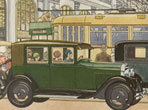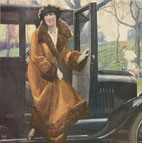
Femininity and the Electric Car
Women Reject the Electric Car
As these pre-World War I reworkings of the notion of separate automotive spheres indicate, many observers recognized that women were driving in increasing numbers, and were not confining themselves to electrics. The most ambitious automotive capitalist might imagine a potential female market numbering into the millions; if such consumers could not be manipulated, they had to be heeded. In 1913, the high-toned Vanity Fair ran a “Casual Cutouts” column on “motoring for the very rich,” highlighting technical information on various vehicles and illustrate with photographs of women drivers. In 1915, a writer for the Illustrated World announced: “Starting a few years go with a little timid venturing on the boulevards in their electrics, women have gradually conquered the motorcar. . . . Their fear of gasoline and monkey wrenches has vanished.” Moreover, middle-class women’s magazines like the Ladies’ Home Journal, sensitive to women’s consumer power in both the magazine and automotive marketplaces, began to include features on driving and maintaining cars. Such publications had also begun to attract auto advertisements.
Notions about femininity and women’s growing demand for automobility had collided in the automotive marketplace, and the chief casualty was the electric car. The surprising thing, however, is not that electrics faded so early, but that they lasted so long, given their manifestly lower power, frequently higher prices, and smaller range than gas cars. Even in their heyday, electrics never comprised more than a tiny share of the market for cars. As early as 1908, according to a survey of fourteen major cities in which electrics were relatively widely used, in no city were more than 900 electrics in operation, and there were fewer than 4,300 electric vehicles in use all together.
TABLE 2 THE NUMBER OF ELECTRICS IN USE, 1908 (Selected Cities)
City |
Approximate Number |
| Toledo, Ohio | 400 |
| Cleveland, Ohio | 650 |
| Atlanta, Georgia | 175 |
Columbus, Ohio |
140 |
| Denver, Colorado | 450 |
| Detroit, Michigan | 250 |
| Washington, D.C. | 300 |
| Chicago, Illinois | 900 |
| Buffalo, New York | 300 |
| Rochester, New York | 350 |
| Indianapolis, Indiana | 125 |
| Hartford, Connecticut | 100 |
| Rockford, Illinois | 75 |
| Binghamton, New York | 75 |
TOTAL |
4290 |
Source: Wilhelm Nassau, Motor magazine, July 1908
The electric car, marketed primarily as a woman’s vehicle, provides a striking example of the influence of gender ideology on automotive production. Paradoxically, the electric’s failure also illustrates the impossibility of maintaining rigid gender distinctions in motorcar technology at a time when a declining proportion of customers could afford the luxury of his-and-hers automobiles, and where in any case consumers shared certain preferences regardless of sex. Still, we should be wary of declaring a victory for technology over culture, for the power of the automobile over the stubbornness of gender ideology. The electric vehicle would slip off the automotive stage, reappearing occasionally at the behest of environmental visionaries and (more often) golfers. Culture, however, continued to influence technology. Since people, regardless of sex, insisted on sitting over an explosion, contested notions about masculinity and femininity entered the domain of the gasoline car.
<<Previous Section - Next Section>>
Early Automobiles and “Separate Spheres”
The Electric Car as a “Woman’s” Vehicle
Women Reject the Electric Car
About the Project | Credits | Contact Us | Student & Teacher Resources | Site Map
©2004 Automobile in American Life and Society


